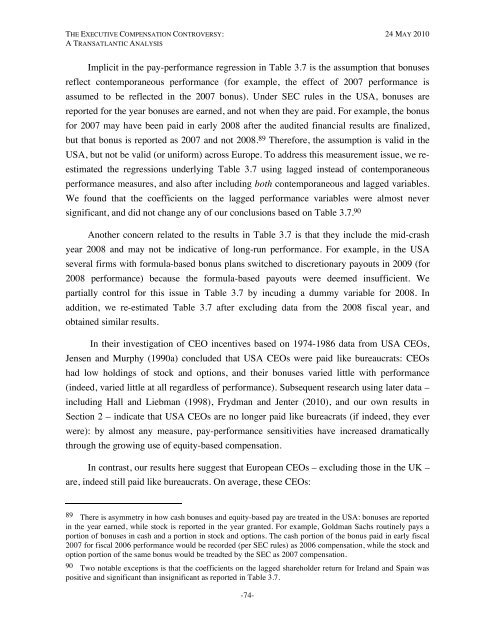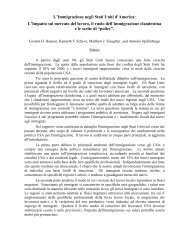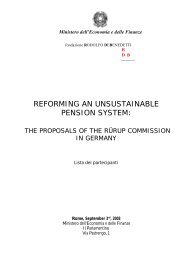The Executive Compensation Controversy - Fondazione Rodolfo ...
The Executive Compensation Controversy - Fondazione Rodolfo ...
The Executive Compensation Controversy - Fondazione Rodolfo ...
You also want an ePaper? Increase the reach of your titles
YUMPU automatically turns print PDFs into web optimized ePapers that Google loves.
THE EXECUTIVE COMPENSATION CONTROVERSY: 24 MAY 2010A TRANSATLANTIC ANALYSISImplicit in the pay-performance regression in Table 3.7 is the assumption that bonusesreflect contemporaneous performance (for example, the effect of 2007 performance isassumed to be reflected in the 2007 bonus). Under SEC rules in the USA, bonuses arereported for the year bonuses are earned, and not when they are paid. For example, the bonusfor 2007 may have been paid in early 2008 after the audited financial results are finalized,but that bonus is reported as 2007 and not 2008. 89 <strong>The</strong>refore, the assumption is valid in theUSA, but not be valid (or uniform) across Europe. To address this measurement issue, we reestimatedthe regressions underlying Table 3.7 using lagged instead of contemporaneousperformance measures, and also after including both contemporaneous and lagged variables.We found that the coefficients on the lagged performance variables were almost neversignificant, and did not change any of our conclusions based on Table 3.7. 90Another concern related to the results in Table 3.7 is that they include the mid-crashyear 2008 and may not be indicative of long-run performance. For example, in the USAseveral firms with formula-based bonus plans switched to discretionary payouts in 2009 (for2008 performance) because the formula-based payouts were deemed insufficient. Wepartially control for this issue in Table 3.7 by incuding a dummy variable for 2008. Inaddition, we re-estimated Table 3.7 after excluding data from the 2008 fiscal year, andobtained similar results.In their investigation of CEO incentives based on 1974-1986 data from USA CEOs,Jensen and Murphy (1990a) concluded that USA CEOs were paid like bureaucrats: CEOshad low holdings of stock and options, and their bonuses varied little with performance(indeed, varied little at all regardless of performance). Subsequent research using later data –including Hall and Liebman (1998), Frydman and Jenter (2010), and our own results inSection 2 – indicate that USA CEOs are no longer paid like bureacrats (if indeed, they everwere): by almost any measure, pay-performance sensitivities have increased dramaticallythrough the growing use of equity-based compensation.In contrast, our results here suggest that European CEOs – excluding those in the UK –are, indeed still paid like bureaucrats. On average, these CEOs:89 <strong>The</strong>re is asymmetry in how cash bonuses and equity-based pay are treated in the USA: bonuses are reportedin the year earned, while stock is reported in the year granted. For example, Goldman Sachs routinely pays aportion of bonuses in cash and a portion in stock and options. <strong>The</strong> cash portion of the bonus paid in early fiscal2007 for fiscal 2006 performance would be recorded (per SEC rules) as 2006 compensation, while the stock andoption portion of the same bonus would be treadted by the SEC as 2007 compensation.90 Two notable exceptions is that the coefficients on the lagged shareholder return for Ireland and Spain waspositive and significant than insignificant as reported in Table 3.7.-74-









